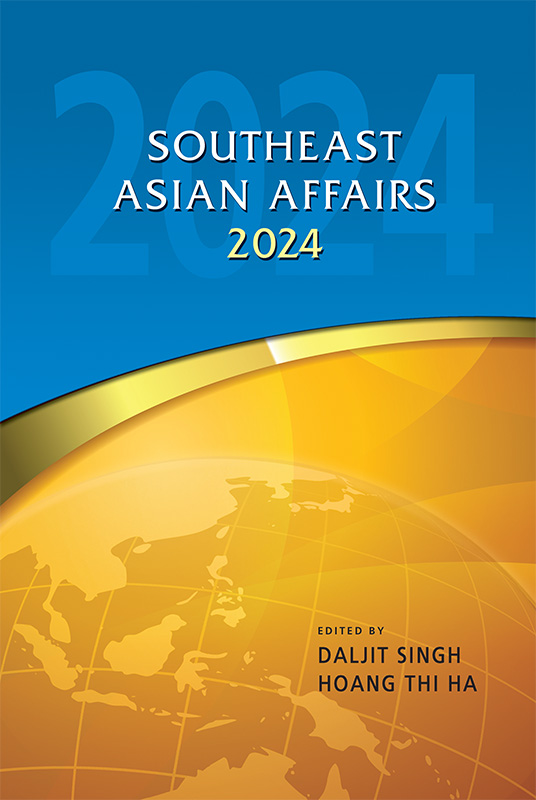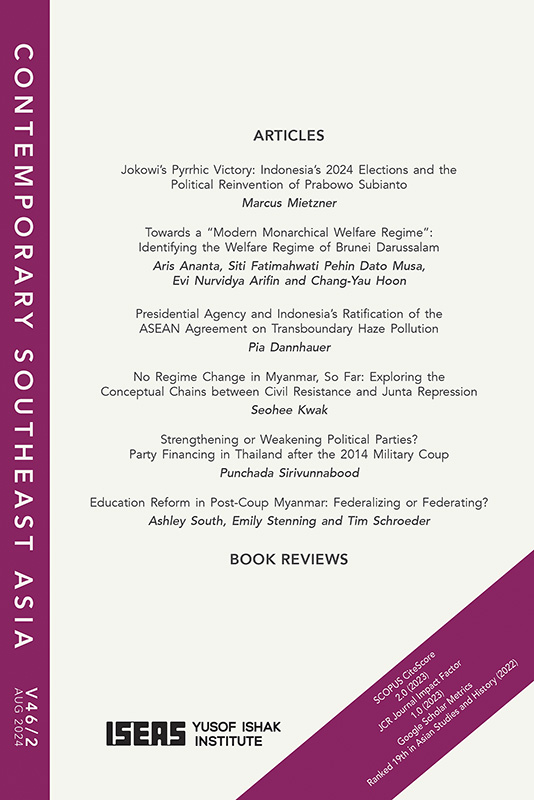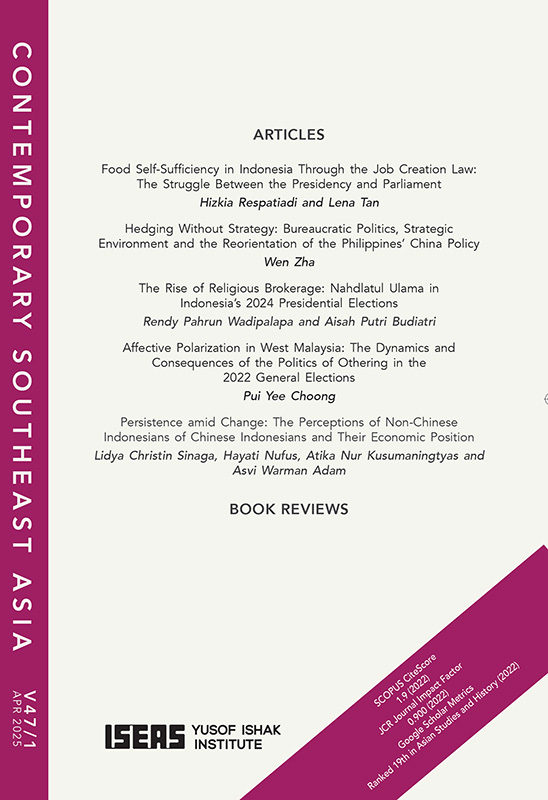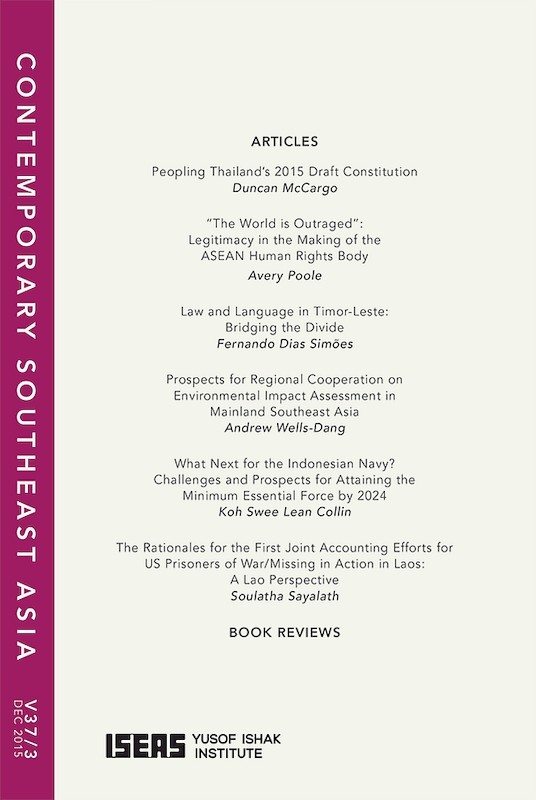Southeast Asian Affairs 2025
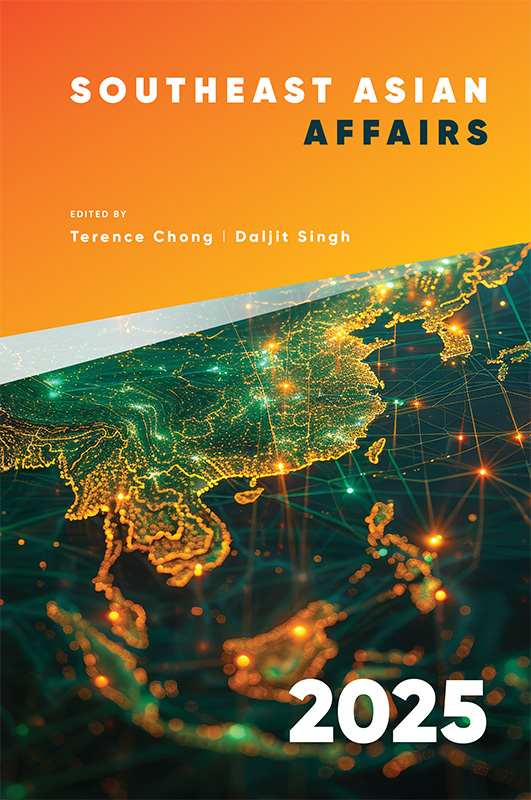
Date of publication:
2025
Publisher:
ISEAS – Yusof Ishak Institute
Number of pages:
383
Code:
SEAA25
Hard Cover
ISBN: 9789815306644
About the publication
Southeast Asian Affairs, produced since 1974, is an annual review of significant trends and developments in the region. The emphasis is on ASEAN countries but important developments in the broader Asia-Pacific region are not ignored. The publication seeks to provide readable and easily understood analyses of major political, strategic, economic and social developments within the region.
Contents
-
Southeast Asian Affairs 2025
[Whole Publication, ISBN: 9789815306651], by Terence Chong, Daljit Singh, editors -
Preliminary pages with Introduction
- THE REGION
-
Continental Drift: Southeast Asia Amidst Regional Wars, Great Power Rivalry, and Globalization at Risk, by Minh Son To, Joseph Chinyong Liow, authors see abstractGlacial but not imperceptible, a “continental drift” is under way as Southeast Asian states increasingly forge their own individual paths to cope with uncertainties accentuated by continued great power rivalry, festering regional crises, and an alarming trend of deglobalization across multiple regions. Divergent priorities and perceptions of the United States have compelled regional states to seek their own intra- and extra-regional linkages beyond the purview of ASEAN, raising questions about the geostrategic salience of the organization, still mute on the Myanmar and South China Sea exigencies. Southeast Asia in 2024 witnessed a number of power transitions and shakeups that suggest more continuity than changes in the regional landscape and their international positions in this regard. Their strategies to act as a “bridging” economy and to “hedge” between two major powers will come under greater scrutiny as Washington casts a suspicious eye at “third countries” through which China attempts to bypass tariffs and regulations even as Beijing is doubling down on trade with the region.
-
Southeast Asia’s Economic Performance and Outlook, by Jayant Menon, author see abstractSoutheast Asia is expected to grow by 4.5 per cent in 2024, with the Philippines, Vietnam and Cambodia the fastest growing. While Indonesia, Malaysia, Thailand and the Philippines returned to their pre-pandemic rates of growth, the newer members of ASEAN appear to have settled at a lower trend growth rate. This positive growth performance was supported by resilient domestic and external demand, driving exports and investment. While the overall outlook remains positive, there has been an increase in external risk and uncertainty, with continuing kinetic and trade wars. US-China tensions have continued to escalate, resulting in increased protectionism and disruption to supply chains. The return of Donald Trump has also raised the possibility of an all-out trade war, which could be disastrous for world trade and growth. Although there may be little that Southeast Asia can do to shield itself from these external pressures, it should continue to not pick sides and avoid retaliatory actions, even if it becomes increasingly difficult to do so.
-
Southeast Asia: Coping with a Challenging Trade Order, by Manu Bhaskaran, author see abstractA vibrant and open global trading system is important for Southeast Asia. But rising protectionism and inward-oriented policies are likely to be a challenge. Policymakers in the region need to be proactive in helping their economies build resilience against these headwinds.
-
The South China Sea Dispute: Philippines-China Tensions Front and Centre, by Ian Storey, author see abstractIn 2024, tensions between the Philippines and China in the South China Sea escalated over a series of dangerous encounters between their coastguards centred on Philippine resupply missions to Second Thomas Shoal. Relations between Vietnam and China were relatively calm because of cordial relations between the two countries’ leaderships. Malaysia’s approach to the dispute remained consistent. The new Indonesian administration led by President Prabowo Subianto appeared to overturn a decades-long policy of refusing to acknowledge the country as a party to the dispute. ASEAN and China failed to make discernible progress on a Code of Conduct for the South China Sea.
- BRUNEI DARUSSALAM
-
Brunei Darussalam in 2024: Steady Growth Amidst New Opportunities and Ongoing Challenges, by Ly Slesman, Chang-Yau Hoon, authors see abstractIn 2024, Brunei Darussalam experienced stronger economic growth, deepened diversification, and navigated an uncertain international political landscape while balancing great power rivalries. As a small nation, Brunei has consistently favoured rules-based multilateral frameworks and collective actions to address global trade and contentious issues. The economy has maintained macroeconomic and financial stability, recovering stronger from the previous year, with significant growth in the non-oil and gas sector, particularly in services, as well as a rebound in oil and gas production. Economic diversification efforts have been bolstered by the expansion of the service sector, digital transformation, and renewable energy initiatives in the downstream industry, supported by ongoing structural reforms. Despite these advancements, challenges persist in diversification, and overcoming them requires continued structural and institutional reforms to drive efforts towards a low-carbon, green economy for sustainable long-term development.
- CAMBODIA
-
Cambodia in 2024: Generational Change and Enduring Autocracy, by Sreang Chheat, Kearrin Sims, authors see abstractThe year 2024 was not a particularly memorable one for Cambodia as it was marked more by political continuity and economic growth than by any significant change. With political stability, the year brought further, much-needed, economic recovery to fund social development and propel the country towards upper middle-income status. The Cambodian People’s Party generational leadership transition, initiated in 2023, has proceeded smoothly, offering opportunities for Cambodia to (re-)engage with the United States and other Western powers while maintaining its strong ties with China. Disappointingly, but not surprisingly, the elite power handover to the country’s “princelings” did not result in any widening space for political participation or any expansion of youth activism. As 2024 drew to a close, Cambodia continued to lack a viable political opposition, while independent media was in tatters and activism remained subdued.
-
Hun Manet’s Worldview: An Exploratory Study, by Chheang Vannarith, author see abstractThis article explores the worldview and leadership style of Cambodian prime minister Hun Manet since taking office in August 2023. Through an analysis of his speeches, policies and governance strategies, it integrates both external (outside-in) and internal (inside-out) perspectives to uncover the philosophical foundations of his leadership. It argues that Hun Manet is trying to navigate a delicate balance between reformist aspirations and the enduring legacy of his predecessor, Hun Sen. His approach is characterized by a blend of continuity and change, grounded in evidence-based policymaking, consensual leadership and a focus on performance-driven legitimacy. In foreign policy, he emphasizes Cambodia’s independence, neutrality and commitment to a rules-based international order, while advocating for open and inclusive multilateralism to foster regional and international cooperation.
- INDONESIA
-
Indonesia in 2024: Limits to Indonesia’s Ambitious Economic Programmes, by Manggi Habir, author see abstractThose expecting that the 2024 election year would see a strong post-Covid recovery were disappointed. Inflation and food prices were high in the first quarter, while market uncertainty and interest rates remained high throughout 2024, ultimately holding back business activity. Weak consumer purchasing power has yet to recover, reflecting the country’s long-term challenge of addressing its shrinking middle class. Sectors that rely on consumer demand have languished, but certain sectors like construction showed high growth and as the former president Joko Widodo’s government rushed to finalize its infrastructure projects, including Nusantara, the country’s new capital in East Kalimantan. President Prabowo’s new government, formed later in the year, has a big challenge ahead given his ambitious goals and programmes. Economic legacy problems as well as limited budgetary flexibility would limit his options. The 2025 government budget has already scaled down spending on his major programmes like the free school lunch programme, making it difficult for the country to go beyond the 5 per cent growth level of past years.
-
2024 Presidential Elections: Reviewing Jokowi’s Influence on Prabowo’s Landslide Victory, by Burhanuddin Muhtadi, author see abstractPrabowo Subianto won the 2024 presidential election by the largest margin in Indonesian history, securing over 96 million votes and defeating his two younger opponents, Anies Baswedan and Ganjar Pranowo. While various interrelated factors influenced the election results, such as the use of social assistance for electoral reasons and the crucial role of social media in campaigns, it was the Jokowi effect that ultimately tipped the scales in Prabowo’s favour. Jokowi’s consistently high approval rating throughout the election cycle aided Prabowo, who campaigned on the promise of continuing Jokowi’s programmes and legacy. Despite certain instances of electoral anomalies, multiple exit poll analysis demonstrate that Prabowo’s massive lead and one-round victory were simply too persuasive to support any electoral fraud allegations. In this regard, one could argue that the 2024 presidential election served as a “referendum” on the continuation of Jokowi’s legacy.
-
From Jokowi to Prabowo: Scrutinizing Indonesia’s Leadership Transition, by Yanuar Nugroho, Sofie Syarief, authors see abstractJokowi’s decade-long presidency concluded with a string of significant achievements for Indonesia. While his development agenda was successful, his tenure has been tainted by criticisms of weakening democratic institutions and processes. The transition to a Prabowo presidency comes amid troubling legal amendments and undemocratic practices that have cast doubt on the integrity of the country’s electoral process. This chapter explores the transition of leadership in Indonesia, reflecting on the achievements and shortcomings of Jokowi’s presidency and how they have shaped the path for his successor, Prabowo. It also examines the political promises made by Prabowo and the challenges that lie ahead for the new president.
- LAOS
-
Laos in 2024: Progress and Persistence, by Floramante SJ Ponce, author see abstractIn 2024, the Lao People’s Democratic Republic (Lao PDR) achieved incremental economic progress, revealing the paradoxical effects of Chinese capital on its economy. The influx of Chinese capital contributed mainly to the 2024 GDP growth rate. However, it also played a part in the accumulation of substantial debts that the Lao state has been struggling to service. These massive debts not just stretched the national budget, but they also weakened the Laotian kip. As Laos has relied on exporting key commodities, the devaluation of the kip, in turn, fuels price hikes. To deal with these persistent macroeconomic difficulties, the Lao state continued implementing strict monetary and protectionist measures. Unlike the economy, the political authority of the Lao state remained stable in 2024. The continuing strength of the Lao state lies in its capacity to mobilize resources from the external environment while maintaining enormous power over internal affairs and its people. The data gathered by the author in 2024 revealed that the Lao state must intensify its efforts to eliminate various threats not only to political and economic stability but also to the future of young Laotians.
- MALAYSIA
-
Malaysia in 2024: From Reformasi to Reformati, by James Chin, author see abstractIn early 2024, Malaysian prime minister Anwar Ibrahim faced political turmoil after the opposition Perikatan Nasional (PN), led by Parti Islam Malaysia, dominated the August 2023 state elections, weakening his Unity Government. Rumours of a “Dubai move” to oust him intensified concerns. However, by year-end, Anwar secured a two-thirds parliamentary majority. Anwar’s strengthened position was primarily due to defections from PN and the opposition’s internal chaos, marked by infighting. The PN leader’s sudden resignation and retraction significantly undermined the opposition’s cohesion and effectiveness. Malaysia’s economy grew by 5.1 per cent in 2024, surpassing prior performance. Anwar’s government tackled long-standing issues with fuel subsidy and pension reforms and resolved Sarawak’s dispute with Petronas, recognizing Sarawak as the gas aggregator while preserving Petronas’s LNG rights. Globally, Anwar championed Palestine and elevated Malaysia’s diplomatic profile, marking fifty years of Malaysia-China ties, assuming the 2025 ASEAN chairmanship, and finalizing the Johor-Singapore Special Economic Zone. These successes strengthened Anwar’s leadership and Malaysia’s economic and international standing.
-
Malaysia: Economic Progress and Political Stasis, by Meredith L Weiss, author see abstractMalaysia in 2024 forged ahead towards high-tech development goals, expanding its niche and attracting impressive investments, but remained largely stymied when it came to institutional reforms. Anwar Ibrahim’s unity government remains stably emplaced, yet still faces existential threats, both from a resilient opposition coalition and from distracting stumbles.
- MYANMAR
-
Myanmar in 2024: Struggle Continues for Glimmers of Light, by Moe Thuzar, Romain Caillaud, authors see abstractIn 2024, Myanmar’s post-coup crisis deepened, marked by escalating conflict, territorial losses for the State Administration Council (SAC), and a widening governance vacuum. Despite retaining control over major urban centres, the SAC lost significant ground in northern Shan and Rakhine States, notably following the intensification of Operation 1027 by ethnic armed organizations. Nationwide enforcement of the conscription law, aimed at replenishing depleted military ranks, triggered widespread resistance and fear. The SAC’s plans for a 2025 election, preceded by a flawed and poorly executed nationwide census, lacked credibility amid ongoing instability and limited administrative reach. Meanwhile, resistance forces and the parallel National Unity Government expanded local governance efforts but also grappled with internal tensions. Internationally, the SAC sought to regain diplomatic standing, particularly with China, while the economy contracted under coercive fiscal controls and investor flight. The year closed with Myanmar entrenched in political fragmentation, humanitarian distress, and uncertain prospects for national reconciliation.
-
From Pawns to Power: How the Arakha Army Came to Dominate Rakhine State, by Kyaw Yin Hlaing, author see abstractIn the fifteen years since its formation, the Arakha Army (AA) has repeatedly defied expectations, and by 2024 it had become one of the most powerful and effective ethnic revolutionary organizations (EROs) in Myanmar, not only in terms of military capabilities but also its ability to mobilize popular support. This chapter explains how and why the AA achieved this feat. It shows that the AA’s clear and comprehensive vision for the future of Rakhine State, and the unhappiness of Rakhine people with the performance of Rakhine politicians and the central government, allowed AA leaders to mobilize unprecedented public support and create a powerful ethnic army within a short time. The chapter also discusses how the multiple theatres of conflict across Myanmar since the 2021 coup d’état undermined the military’s ability to contain the military and political expansion of the AA in Rakhine State. The chapter ends with a discussion of the challenges the AA may face in establishing an effective administration, even if it manages to take over the whole of Rakhine State. These include the ongoing impact of conflict, the expectations of the ethnic Rakhine population, rule of law, and intercommunal tensions (both between the Rakhine and Rohingya and, if the AA maintains control of Paletwa Township in Chin State, with the Chin).
- THE PHILIPPINES
-
The Philippines in 2024: Disruptions, Distractions and Dynasties, by Aries A. Arugay, author see abstractIn 2024, the Philippines experienced a series of turbulent yet compelling sociopolitical transformations. This chapter categorizes these developments into three broad themes: domestic political distractions, external disruptions challenging foreign policy, and the unravelling of the republic’s most powerful dynastic alliance. Rather than advancing towards the fulfilment of his campaign promises, President Ferdinand Marcos Jr. found himself navigating and engaging in hyper-partisan politics. Notable episodes included the unsuccessful bid to amend the 1987 Constitution and intense political infighting with the Duterte dynasty. Meanwhile, foreign policy challenges posed significant disruptions, evidenced by China’s increasingly assertive actions in the West Philippine Sea, revelations of Beijing's influence operations within the country, and uncertainties stemming from the outcome of the United States presidential election. These factors drove the government to deepen security cooperation with like-minded states. Despite posting robust growth rates, the Philippine economy has yet to achieve its full potential as the Marcos Jr. administration approaches its midpoint. This chapter concludes by examining the possible trajectories for the nation in light of its precarious political landscape, as well as the implications of the forthcoming legislative and local elections scheduled for May 2025.
-
Tightrope Diplomacy: Philippine Foreign Policy Recalibration Under Marcos Jr. amid South China Sea Tensions and Political Rifts, by Lowell Bautista, Nathaniel Punongbayan Candelaria, authors see abstractIn 2024, the Philippines, under President Ferdinand Marcos Jr., navigated a pivotal year in foreign policy shaped by rising geopolitical tensions and internal political challenges. This chapter examines the Philippines’ recalibration towards a more assertive stance in the South China Sea, marked by a decisive pivot back to the United States and the pursuit of stronger regional partnerships. High-profile defence agreements and expanded military exercises underscored the administration’s resolve to counter China’s maritime assertiveness. Simultaneously, domestic political turbulence, including the collapse of the “UniTeam” alliance and growing scrutiny of the Duterte legacy, has influenced this recalibration, with foreign policy serving as both a strategic response to external threats and a tool for domestic legitimacy. The chapter also explores the broader implications of this shift, highlighting how the Philippines balances sovereignty, alliance-building, and adherence to a rules-based international order. While these moves have bolstered national pride and international credibility, they have also drawn scepticism from ASEAN neighbours wary of deeper US alignment. Ultimately, the chapter provides a nuanced analysis of how the Marcos administration’s foreign policy reflects a high-stakes effort to secure the place of the Philippines in an increasingly polarized Indo-Pacific region.
- SINGAPORE
-
Singapore in 2024: Uneventful Generational Leadership Change, Humming Economy amid Cost-of-Living Concerns, and Rallying Team Singapore, by Eugene K B Tan, author see abstractSingapore’s third generational change in political leadership took place in 2024. In May and November, the curtain came down on Lee Hsien Loong’s two-decade tenure as prime minister and as secretary-general of the ruling People’s Action Party (PAP), respectively, with Lawrence Wong succeeding him. The PAP also marked seventy years of its founding and its sixty-fifth year in government, recognizing that the political landscape is increasingly more diverse and competitive, with a consequential general election in 2025 that could determine Singapore’s political evolution for the next decade or more. GDP growth exceeded expectations and bettered the previous year’s performance. The economy grew 4 per cent in 2024 on the back of overall external demand remaining resilient. Making sense of the continuing geopolitical turmoil and economic uncertainty, not least with Donald Trump’s election as US president, will require the new fourth-generation leadership to demonstrate that they are equal to the task of governing Singapore.
-
Assets and Challenges: Singapore’s Third Prime Minister, Lee Hsien Loong, Hands over to Successor, by Gillian Koh, author see abstractThis chapter reviews the key achievements of Singapore’s third prime minister, Lee Hsien Loong, over his twenty years at the helm in the areas of foreign policy, economic development, social support systems, political institutions and governance systems. He sought to build an open and inclusive society, one that helped to attenuate social inequality as its economy moved up the technological ladder. In ensuring that the city-state’s relationship with its neighbours and the major powers were in good order externally and that habits of collaborative governance were set in place domestically, his successor, Mr Lawrence Wong, can be assured that he begins his own journey of leadership with diplomatic, economic, fiscal, social and governance assets to draw on, as Singapore faces a more complex and uncertain world than ever before.
- THAILAND
-
Thailand in 2024: Institutional Reform Impossible and Instability Continues, by Puangthong Pawakapan, author see abstractThe 14 May 2023 general election ended the nearly decade-long military rule of General Prayut Chan-ocha, yet Thailand’s journey towards democratic consolidation remains hindered. The conservative establishment—including royalists, the military, senior bureaucrats, the judiciary, business elites, right-wing political parties, and independent organizations— emerged victorious, maintaining its ability to influence the country’s political trajectory. It has continued to target and suppress the most progressive party, now known as the People’s Party, a rebirth of the previously dissolved Move Forward Party. At the same time, the government led by the Pheu Thai Party (PTP) remains unstable, as its alignment with military-backed parties—in exchange for Thaksin’s safe return to Thailand—has drawn criticism for abandoning its reform pledges. As a result, trust in the PTP is eroding as support from its voter base continues to decline. The PTP is also facing serious legal battles waged by conservative factions. On the economic side, the government’s performance has failed to help the country exit a period of economic stagnation. Its policies have emphasized short-term populist strategies over necessary structural reforms, failing to address Thailand’s economic challenges.
-
Thailand’s Economic Challenges in 2025, by Archanun Kohpaiboon, author see abstractThis chapter analyses Thailand’s recent economic performance to identify and prioritize the country’s key economic challenges in 2025. Promoting sustained economic growth remains the foremost policy concern for Thailand. A major impediment continues to be the sluggish pace of private investment, a longstanding issue since the early 2000s that continues to hinder economic momentum. Conversely, the export of goods and services has remained a relatively strong contributor to growth. While exports remain important to driving growth, they alone are insufficient to offset broader structural weaknesses. Thailand’s structural transformation requires not the selection of specific industrial sectors, but rather the effective management of a transition towards more dynamic and growth-promoting activities—particularly within the context of uncertainty brought about by disruptive technologies. However, two additional challenges complicate this process: heightened global economic uncertainty, which undermines export prospects, and the growing influx of Chinese imports, which has displaced many indigenous firms from the domestic market.
- TIMOR-LESTE
-
Timor-Leste in 2024: Stable at Home, Progress on Foreign Policy, by Max Lane, Julia Lau, authors see abstractAmid a period of relative domestic stability on the political and social fronts, Timor-Leste successfully hosted a historic visit by Pope Francis in September 2024. Political succession beyond the country’s political patriarchs remains uncertain. At the same time, Timor-Leste continued preparing for its expected accession to ASEAN. Diversifying the Timorese economy from its reliance on oil and gas revenues is a challenge, as is navigating the fallout from the US-China rivalry. However, Timor-Leste is increasing its linkages to regional neighbours and other like-minded countries on various fronts, including in environmental, security and social justice matters.
- VIETNAM
-
Vietnam in 2024: Back in Business?, by Paul Schuler, author see abstractVietnamese politics shifted in 2024 with the death of General Secretary Nguyen Phu Trong and the ascension of To Lam. This chapter assesses Trong’s legacy and the changes likely to occur under Lam. It argues that while Trong did not personalize power as much as feared, he did weaken the 1992 consensus, where power was divided between the state and the party, with the state led by southern economic reformers and the party by northern ideological leaders. The chapter also suggests that the most important likely changes will be a deprioritization of the anti-corruption campaign and an emphasis on government streamlining. The chapter closes by reviewing Vietnam’s economic prospects and prospects for civil society under the new leadership.
-
Vietnam at the Crossroads: Opportunities and Challenges in Global Supply Chain Restructuring, by Banh Thi Hang, author see abstractThis chapter delves into the opportunities and challenges that Vietnam faces amid the restructuring of global supply chains and the ongoing transition of the global economy. It examines how the country can leverage its strengths to capitalize on shifting manufacturing trends while addressing the obstacles that could hinder its progress. By exploring Vietnam’s role in the evolving global trade environment, this chapter aims to provide insights into its potential trajectory as a key player in international supply chains.

